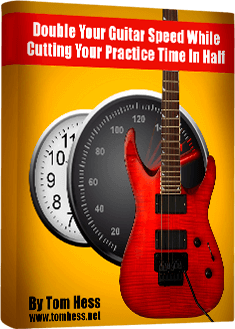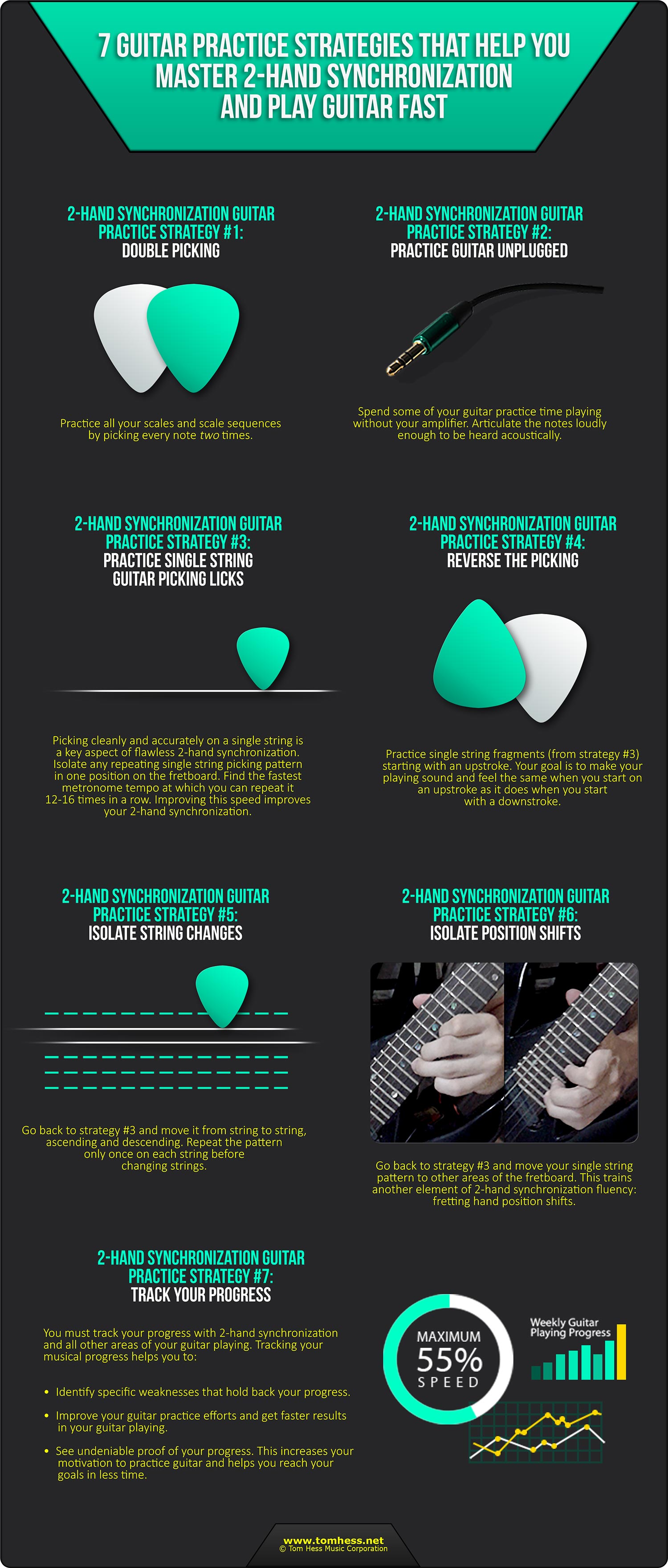How To Clean Up Sloppy Guitar Playing And Play Guitar Cleanly Like A Pro
BY AT LEAST 100%

EMAIL TO GET ACCESS
By submitting your info, you agree to send it to Tom Hess Music Corporation who will process and use it according to their privacy policy.
If you struggle with sloppy guitar playing...
Then this lead guitar article will show you:
- the common sources of guitar string noise (and what things can make it hard to play guitar cleanly)
- proven lead guitar techniques that help you tighten up sloppy 2-hand synchronization and get rid of guitar string noise for good
- how to sound like a pro (even if you can’t play guitar fast yet and don’t have a lot of time to practice your lead guitar chops)
The first thing to know about cleaning up sloppy guitar playing is...
There are 2 types of problems that get in the way of your goal to play guitar cleanly:
There is noise from the strings (and notes) you are trying to play in your lead guitar licks.
(This noise often happens when your 2 hands get out of sync.)
And then...
There is guitar string noise that comes from the strings you don’t want to hear.
BY AT LEAST 100%

EMAIL TO GET ACCESS
By submitting your info, you agree to send it to Tom Hess Music Corporation who will process and use it according to their privacy policy.
What are the techniques for fixing each type of guitar string noise?
This lead guitar video covers them in detail:
Now that you know the basics of what it takes to play guitar cleanly, let’s go deeper.
Here are 5 more in-depth ways to clean up sloppy guitar playing and sound like a pro when you play lead guitar:
Tip #1 For Controlling Guitar String Noise: Use Directional Picking Instead Of Alternate Picking
First, what is directional picking?
It’s a lead guitar technique where you use strict alternate picking when you pick on the same string...
And when you change strings – you pick in the direction of the next string (no matter what note came before).
Here is an example of directional picking:
So, what the heck does ‘directional picking’ have to do with cleaning up sloppy guitar playing?
Well, a lot, actually.
You see, directional picking is much more efficient than strict alternate picking.
When you play 3-note-per-string scales, for example, your pick can go directly to the next string without skipping over the string you are about to play.
This does 2 things:
1. It makes it easier to build a ton of guitar speed (without having to practice more), because you are literally moving your pick a 33% shorter distance with directional picking than it would move with alternate picking.
2. Because you are making smaller motions, there is less of a chance of a 2-hand synchronization breakdown.
So, directional picking plays a very important role in helping you play guitar cleanly and control guitar string gnoise.
Question: “But Tom Hess, isn’t alternate picking a better technique for accenting the notes when you play lead guitar and want to maintain tight 2-hand synchronization?”
Answer: No, absolutely not.
Directional picking generates more power on string changes when you move the pick in the direction of the next string.
Here is a simple reason why (using 3-note-per-string scales as an example):
You are using momentum from the previous pick stroke (that the hand is still in motion for) to initiate the first pick stroke on the next string.
This means the motion on the new string becomes stronger (since the pick doesn't have to stop moving between notes). With alternate picking, the pick has to travel over the string you are going to and STOP, change direction and build momentum again to arrive to the first note on string changes.
Besides: no matter which technique you use, there will be some guitar licks where some pick strokes will be easier to accent than others. Your ability to accent notes depends on YOU – not on the technique you use.
So, you might as well use the lead guitar technique with the most efficiency, greater 2-hand synchronization potential that makes it easier to play guitar cleanly and control guitar string noise.
If you are still not convinced that directional picking I the best lead guitar technique for building speed (and controlling guitar string noise), check out this guitar technique article that settles the debate once and for all.
Tip #2 For Controlling Guitar String Noise: Practice A Lot Using Distortion
Some guitar players (falsely) believe that playing with distortion ‘masks’ lead guitar playing mistakes.
This couldn’t be further from the truth... especially when it comes to your ability to play guitar cleanly and fix sloppy guitar playing.
Distortion amplifies guitar string noise issues (especially those that come from not properly muting open strings – the strings you are not playing). And because distortion makes them louder, they become more obvious.
 Improve Guitar Technique Fast
Improve Guitar Technique FastLearn how to quickly improve
your accuracy onlead guitar.
 Transform Your Guitar Playing
Transform Your Guitar PlayingInstantly improve your guitar
playing with these free tips.
 Become A Faster Guitar Player
Become A Faster Guitar PlayerLearn how to reach maximum
speed in your guitar playing.
These sloppy guitar playing mistakes begin bother you more.
And this means you’ll be more likely to fix them.
Plus: because distortion makes sloppy guitar playing mistakes ‘louder’, it also makes it easier to tell when they are gone from your lead guitar playing.
To be clear: distortion does mask inconsistencies in pick attack and articulation (which is why I will show you a different strategy for fixing them later in this lead guitar article).
But for fixing the majority of sloppy guitar playing mistakes? Distortion is your friend.
Specifically, I recommend using distortion between 70-80% of your lead guitar practice time.
Use as much distortion as you typically use in your guitar solos.
Question: “Tom Hess, is it ok to also play with effects like delay, chorus, wah pedal, etc. when trying to control sloppy guitar string noise?”
Answer: No, do not use effects. Effects are the things that mask mistakes. Delay, for example, makes it hard to tell when you are having 2-hand synchronization issues (so does the wah pedal).
So, only use dry distortion when practicing lead guitar (and working on your ability to play guitar cleanly).
But when you are playing?
Use all the lead guitar effects you want.
Tip #3 For Controlling Guitar String Noise: Work On Your Pick Attack And Articulation
How does pick attack and articulation help with fixing sloppy guitar playing and controlling guitar string noise?
Here are a few reasons:
1. The faster you play, the more pick attack is needed to maintain 2-hand synchronization on the notes and make the notes sound clean. So, the more you focus on your pick attack at slower tempos, the easier it becomes to play lead guitar cleanly at every speed.
2. Louder pick attack helps drown out guitar string noise (even when it is present in your playing). Of course, if you use the string muting techniques I described earlier in this article, guitar string noise will very likely be a nonissue.
That said, louder and more articulate pick attack will act as another layer of defense against sloppy guitar playing. (Plus, it makes your lead guitar playing sound more expressive, by giving you more control over dynamics.)
Here are some ways to improve your pick attack and 2-hand synchronization (so you can play guitar cleanly without guitar string noise):

Here is a bonus pick attack and 2-hand synchronization training drill that will help you play guitar cleanly:
Play your guitar scales and scale sequences horizontally (from the lowest fret to the highest fret) on the thickest strings (strings 6 and 5 of your guitar).
This will make it challenging to articulate the notes clearly, but that challenge will make you better faster.
Question: “Tom Hess, one of the points in the infographic above talks about playing guitar unplugged! But didn’t you say earlier that it’s important to practice guitar with distortion because distortion amplifies mistakes?”
Answer: There are different types of sloppy guitar playing mistakes that can limit your ability to play guitar cleanly. Weak articulation (and sloppy 2-hand synchronization) is one of them. And playing guitar unplugged is the best way to spot and fix these lead guitar issues that cause guitar string noise.
Tip #4 For Controlling Guitar String Noise: Use Focus Rotation To Check For Each Possible Cause Of Sloppy Noise.
With all the possible causes of guitar string noise that can make your lead guitar playing sound sloppy, there are a lot of things to pay attention to.
And even if you have a lot of time to practice your lead guitar playing (and a lot of time to dedicate to fixing sloppy guitar playing)...
It can still be very overwhelming to know what to focus on and when.
The solution?
Focus rotation.
What is focus rotation?
It’s a lead guitar practice method where you make a list of all the elements you need to focus on and alternate (rotate) your focus between them – one at a time – as you practice.
For example: say you want to focus on: 3 ways to train (and refine) your 2-hand synchronization, improve your consistency with thumb muting, as well as your pick attack.
Here is how you use focus rotation to refine these elements of guitar string noise control and improve your ability to play guitar cleanly:
Step 1: Make a list of the lead guitar practice techniques you want to work on (the techniques above).
Step 2: Choose a lead guitar practice item (an exercise) to play for 10-20 minutes.
Step 3: Play your lead guitar exercise over and over, focusing on the first of your elements (of sloppy guitar playing control) from step 1 for 2-3 minutes. (For example: controlling 2-hand synchronization.) Ignore the other items in step 1 for those 2-3 minutes.
Step 4: Rotate your focus to another element of guitar string noise control (that helps you play guitar cleanly) for the next 2-3 minutes.
Continue playing your lead guitar practice item like nothing happened.
(Nobody should be able to tell just by listening that you are focusing on a different aspect of guitar string noise control.)
Step 5: After 2-3 minutes, switch again (mentally rotate focus to the next item in your sloppy guitar playing control list) and keep going like this until the time runs out.
This practice method is a fantastic way to learn to play guitar cleanly and eliminate guitar string noise... without spending a lot of time.
For more tips on how to use focus rotation to become a better lead guitarist (and all-around musician), check out this live stream I did with guitar practice expert Mike Philippov that’s all about focus rotation:
Tip #5 For Controlling Guitar String Noise: Play Extra Slow To Listen For Noise Between Notes.
An under-appreciated way to fix sloppy guitar playing is to simply play your lead guitar licks excessively slowly (as in: play the licks in whole notes and half notes to the metronome).
How does that help you clean up guitar string noise and play guitar cleanly?
The space between notes will expose sloppy guitar playing much more and draw your attention to it.
For example, it will make it obvious when you are not doing thumb muting the right way or when your 2-hand synchronization isn’t perfectly tight... forcing you to fix it.
Alternate this way of practicing with the other approaches described in this article to have a much easier time controlling guitar string noise.
Now that you know how to clean up sloppy guitar playing, the next step to mastering your lead guitar playing is to relax excess muscle tension in your body. Excess tension causes you to make more mistakes and makes playing guitar feel like a struggle. There are 9 causes of excess tension that – when fixed – make it much easier to play guitar fast and clean (and make you sound better with everything you already play). Discover what they are and how to relax them in my free video master class Total Tension Control and unlock a lifetime of faster and easier guitar gains.

Transform your guitar playing with the world’s best and most proven online guitar lessons.

